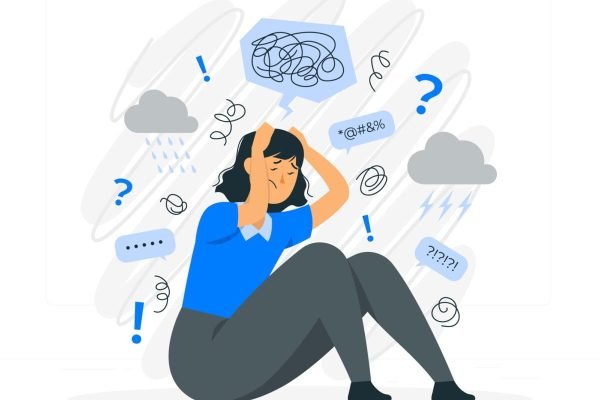Author – Rohit. B. Sharma
A panic attack is defined as a sudden episode of intense fear that triggers severe physical reactions when there is no real danger or apparent cause. Many physical symptoms will be seen like acute pain, breathing difficulties, sweating, etc.
What is a Panic Attack?
A person may feel like they are in imminent danger and feel extremely fearful whether or not that is the case. These are brief periods of intense anxiety which trigger a sensation of fear in them. These attacks are often been triggered either due to an anxiety-provoking situation or because of a mental health disorder (e.g., mood disorders, substance-related disorders). It’s not necessary that a panic attack is triggered only because of some situation. It also can be triggered when someone least expects it (e.g., while relaxing or sleeping). From this, we can very well understand how stressful a panic attack is to a person. They will interfere with an individual’s day-to-day activities. People tend to alter their lifestyles to avoid these attacks. Panic attacks can occur as frequently as several times daily or as rarely as some times a year.
What are the signs & symptoms?
The following are several of the symptoms of a panic attack:
- Palpitations, pounding heart, or accelerated pulse rate
- Sweating
- Trembling or shaking
- Smothering or breathing difficulties
- Feeling of choking
- Chest pain or discomfort
- Nausea or abdominal distress
- Feeling dizzy, unsteady, lightheaded, or faint
- Frightened of losing control or going crazy
- Fear of dying
- Paresthesias (numbness or tingling sensations)
- Chills or hot flushes
If any 4 (or more) of the above-mentioned symptoms develop abruptly & intensifies within a span of 10 minutes, then someone can be said to experience a panic attack.
What causes a Panic Attack?
It is a well-known fact that the body triggers a ‘flight-or-fight’ response when it is faced with imminent danger. A good range of hormones are released (e.g., adrenaline) which causes a physiological change in our body (e.g., dilated pupils, rapid heartbeat and breathing, increased pressure, etc), which enables us to face dangerous situations effectively.
A panic attack occurs when there is an activation of the ‘flight-or-fight’ response within the absence of a dangerous situation. The unwanted activation of the ‘flight-or-fight’ response results in physiological changes within the body which may be seen as a panic attack.
Some factors that cause the unwanted activation of the ‘flight-or-fight’ response are:
- Chronic (ongoing) stress – this causes the body to release over usual levels of stress chemicals like adrenaline.
- Acute stress (such as experiencing a traumatic event) – can suddenly flood the body with large amounts of stress chemicals.
- Habitual hyperventilation – disturbs the balance of blood gases because there is a lack of CO2 within the blood.
- Intense workout – for some people, this might cause extreme reactions.
- Excessive caffeine intake – the caffeine in coffee, tea and other beverages may well be a powerful stimulant.
- Illness – may cause physical changes.
- A sudden change of environment – like walking into an overcrowded, hot or stuffy environment.
- Medications & drugs – can also induce panic-like situations.
Can Panic Attacks be treated?
If a person thinks that they experience frequent panic attacks, they have to first consult a psychological state professional. Don’t engage in self-diagnosis and treatment.
Psychotherapy or medications and sometimes a mixture of both are usually used to treat panic attacks.
Psychotherapy
Cognitive Behavioural Therapy (CBT), a research-supported style of psychotherapy, is one of the commonly used methods to treat anxiety disorder. It mainly focuses on teaching the individual alternative ways of thinking, behaving, and reacting to the sentiments going down during and after the fright. The frequency of the attacks lowers once a person can handle their sensations of fear and anxiety during the attack.
Medications
The different sorts of medications prescribed by a mental health professional are:
- Antidepressants, such as SSRIs (selective serotonin reuptake inhibitors) and SNRIs (serotonin-norepinephrine reuptake inhibitors)
- SSRI and SNRI antidepressants are usually used to treat depression, but they can even be used for the treatment of panic attacks. They take some weeks to indicate a major effect. There could also be side effects, like headaches, nausea, or difficulty sleeping.
- Beta-blockers
- Beta-blockers help in controlling the physical symptoms of panic attacks, such as rapid rate, sweating, and tremors.
- Anti-anxiety medications
- Anti-anxiety medications like Benzodiazepines are effective in rapidly decreasing fear symptoms.
Leading a healthy lifestyle can reduce the danger of getting a panic attack. Maintaining a healthy diet, getting enough sleep, and having healthy interactions with family & friends have proven to be effective against panic attacks.
References
Panic Disorder: When Fear Overwhelms. (n.d.). National Institute of Mental Health (NIMH). Retrieved July 19, 2022, from https://www.nimh.nih.gov/health/publications/panic-disorder-when-fear-overwhelms
Panic attacks and panic disorder – Diagnosis and treatment – Mayo Clinic. (n.d.). Panic Attacks and Panic Disorders. Retrieved July 19, 2022, from https://www.mayoclinic.org/diseases-conditions/panic-attacks/diagnosis-treatment/drc-20376027#:%7E:text=SSRIs%20approved%20by%20the%20Food,are%20another%20class%20of%20antidepressants.
Panic attack – Better Health Channel. (n.d.). Panic Attack. Retrieved July 19, 2022, from https://www.betterhealth.vic.gov.au/health/conditionsandtreatments/panic-attack#what-is-a-panic-attack
Butcher, J. N., Mineka, S., & Hooley, J. M. (2012). Abnormal Psychology (15th ed.). Pearson College Div.

